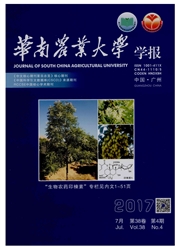

 中文摘要:
中文摘要:
【目的】以先前研究所获得的8个与大口黑鲈生长性状相关的分子标记为检测目标,分析其优势基因型在大口黑鲈选育群体中的分布数量,探索生长相关分子标记应用于大口黑鲈基因聚合育种的潜在可行性.【方法】采用STR基因分型技术对大口黑鲈‘优鲈1号’F2、F3、F5和F6选育群体的生长标记基因型进行检测,8个生长标记中含有4个单核苷酸多态性位点(分别位于IGF-I、POUIF1、PSS皿和MSTN基因上)和4个微卫星位点(分别是JZL60、JZL67、MisaTpw76和MisaTpw117).【结果和结论】试验鱼所含优势基因型的数量为0—6个,F2、F3、F5和F6选育群体中优势基因型的分子标记平均数量依次为2.12、2.70、2.90和3.08,呈现逐代递增趋势;优势基因型的分子标记数量与大口黑鲈生长速度呈同步递增趋势,说明人工选育在一定程度上聚合了优势基因.
 英文摘要:
英文摘要:
[ Objective ] Eight molecular markers related to growth traits were detected in the different breeding populations of largemouth bass, which had been found by previous studies. This would provide useful information for the actual application of limited growth markers in gene pyramiding breeding of largemouth bass. [ Method ] Using the technology of STR genotyping, genotype of 8 growth markers in the F2, F3, F5 and F6 generations of largemouth bass (Micropterus salmoides) , ' Youlu No. 1 ' were de- tected and the number of advantage genotypes was analyzed. The growth markers included four sites of single nucleotide poiymorphism located in IGF-I, POUIF1, PSS Ill and MSTN gene and four sites of mic- rosatellite: JZL60, JZL67, MisaTpw76 and MisaTpw117. [Result and conclusion] The number of ad- vantage genotypes was 0 - 6 in the tested fishes. The average number was 2.12, 2.70, 2.90 and 3.08 in F2, F3, F5 and F6 generations, respectively, presenting an increasing trend with each generation. The number of the advantage genotypes increased synchronously with the growth rate of the breeding largemouth bass in different populations. This means that the artificial selection has polymerized the advantage genotype to some extent.
 同期刊论文项目
同期刊论文项目
 同项目期刊论文
同项目期刊论文
 tissue distribution and effectsof fasting on pituitary adenylate cyclase-activating polypeptide in l
tissue distribution and effectsof fasting on pituitary adenylate cyclase-activating polypeptide in l 期刊信息
期刊信息
